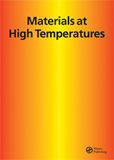
MATERIALS AT HIGH TEMPERATURES
Scope & Guideline
Charting the Course for Future High-Temperature Innovations
Introduction
Aims and Scopes
- Creep Behavior and Mechanisms:
A core area of focus is the study of creep behavior in various materials, particularly at high temperatures. This includes understanding the mechanisms of creep deformation, life prediction, and the development of models to characterize this behavior. - High-Temperature Corrosion and Oxidation:
Research on the resistance of materials to high-temperature corrosion and oxidation is significant, especially for applications in energy production and aerospace. Studies often explore the effects of different environments on material degradation. - Microstructural Evolution:
The journal frequently addresses the microstructural changes that occur in materials under high-temperature conditions, which can significantly influence mechanical properties and performance. - Material Characterization Techniques:
Innovative techniques for characterizing materials, such as advanced microscopy and mechanical testing, are emphasized to enhance the understanding of material behavior under extreme conditions. - Additive Manufacturing and Novel Materials:
There is a growing interest in the development and evaluation of materials produced through additive manufacturing techniques, particularly their mechanical properties and high-temperature performance. - Weld Integrity and Joint Performance:
The journal also focuses on the integrity of welded joints and the performance of different materials in composite structures, particularly in high-stress environments.
Trending and Emerging
- Advanced Coatings and Surface Treatments:
There is a growing trend towards the development and study of advanced coatings and surface treatments designed to enhance the performance of materials under high-temperature conditions, particularly in corrosion resistance. - Creep-Fatigue Interaction Studies:
Research focusing on the interactions between creep and fatigue is on the rise, emphasizing the need to understand how these two phenomena affect material performance in service. - Sustainability and Environmentally Friendly Materials:
Emerging research is increasingly focused on sustainability, with studies exploring environmentally friendly materials and processes, particularly in the context of energy production and industrial applications. - Numerical and Computational Modeling:
The use of advanced computational techniques and numerical modeling to predict material behavior under high-temperature conditions is trending, with a focus on enhancing predictive capabilities. - Hybrid Materials and Composites:
The exploration of hybrid materials and composites that combine different material properties for enhanced performance at high temperatures is becoming more prominent, reflecting the need for innovation in material design.
Declining or Waning
- Generalized Creep Models:
There has been a noticeable decrease in papers focused on generalized creep models that do not account for specific material behaviors or conditions. As research becomes more tailored to specific materials and applications, broad models may fall out of favor. - Basic Material Testing at Standard Conditions:
Research focusing on basic mechanical properties of materials at standard conditions is becoming less common, as the emphasis shifts towards real-world applications and extreme conditions. - Traditional Alloy Systems:
Traditional alloy systems, particularly those that have been extensively studied in the past, are seeing a reduction in new contributions, likely due to saturation of knowledge and the emergence of novel materials.
Similar Journals
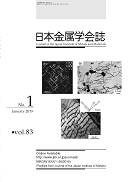
Journal of the Japan Institute of Metals and Materials
Illuminating the future of materials science and engineering.Journal of the Japan Institute of Metals and Materials (ISSN: 0021-4876, E-ISSN: 1880-6880) serves as a vital academic platform under the esteemed auspices of the Japan Institute of Metals & Materials. This journal, with a rich publication history dating back to 1937, focuses on advancing knowledge in the fields of metallurgy, materials science, and engineering, making it an important resource for researchers, professionals, and students alike. Although the journal has been categorized in Q4 quartiles across several subject areas, including Condensed Matter Physics and Materials Chemistry, it plays a critical role in disseminating essential findings and fostering discussion regarding innovations in metal and materials research. Notably, the journal operates without open access, which encourages targeted readership engagement through its curated content. Based in Japan, it continues to contribute significantly to the academic community by bridging the gap between scientific inquiry and practical application in materials technology.

Materiali in Tehnologije
Empowering Researchers in Metals and PolymersMateriali in Tehnologije is a distinguished peer-reviewed journal dedicated to the field of materials science, focusing specifically on metals and polymers. Published by the Institute for Metals and Materials Technology in Slovenia, this open-access journal has been at the forefront of disseminating research findings and innovative technologies since 2000. With a current impact factor that reflects its increasing visibility in the academic community, Materiali in Tehnologije serves as an invaluable resource for researchers, professionals, and students alike, encompassing a wide array of studies in the categories of Metals and Alloys, as well as Polymers and Plastics. The journal is indexed in Scopus, highlighting its relevance and contribution to the field, particularly with its ranks of Q3 in Metals and Alloys and Q4 in Polymers and Plastics. As it converges towards 2024, Materiali in Tehnologije continues to be a pivotal platform for knowledge exchange, encouraging advancements in materials research and technology.
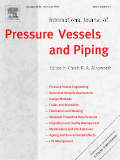
INTERNATIONAL JOURNAL OF PRESSURE VESSELS AND PIPING
Your premier source for cutting-edge mechanical engineering insights.International Journal of Pressure Vessels and Piping, published by Elsevier Science Ltd, stands as a premier platform in the fields of Materials Science, Mechanical Engineering, and Mechanics of Materials. With a rich history spanning from 1973 to 2024, this journal has consistently ranked in the Q2 category of its respective fields, affirming its relevance and contribution to ongoing research and innovation. As evidenced by its solid positioning in Scopus rankings, including a notable 74th percentile rank in Mechanical Engineering, it is a valued resource for professionals, researchers, and students seeking to expand their knowledge on topics related to pressure vessels and piping systems. While the journal does not currently offer Open Access, its comprehensive articles and peer-reviewed research continue to make a significant impact, ensuring that readers stay informed of the latest advancements and methodologies in the industry. Available in both print and online formats, the International Journal of Pressure Vessels and Piping is your go-to source for authoritative insights and cutting-edge studies in the engineering domain.
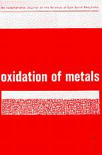
OXIDATION OF METALS
Pioneering Research on Metal ResistanceOXIDATION OF METALS, published by SPRINGER/PLENUM PUBLISHERS, stands as a pivotal journal in the fields of Inorganic Chemistry, Materials Chemistry, and Metals and Alloys. Established in 1969, it has consistently contributed to advancing knowledge and research on the oxidation processes in metals, essential for various industrial applications and theoretical frameworks. With an impact factor that reflects its respected position—ranked Q2 in key scientific categories—this journal facilitates cutting-edge discourse among researchers and practitioners alike. The journal is committed to open access, ensuring that groundbreaking research on metals’ behavior and resistance to oxidation is available to a broader audience, enhancing collaboration and innovation. Spanning over five decades, OXIDATION OF METALS continues to be a crucial resource for scholars and professionals aiming to stay at the forefront of materials science and engineering.
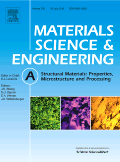
MATERIALS SCIENCE AND ENGINEERING A-STRUCTURAL MATERIALS PROPERTIES MICROSTRUCTURE AND PROCESSING
Exploring Innovations in Structural MaterialsMATERIALS SCIENCE AND ENGINEERING A-STRUCTURAL MATERIALS PROPERTIES MICROSTRUCTURE AND PROCESSING, published by ELSEVIER SCIENCE SA, is a highly regarded journal specializing in the fundamental and applied aspects of materials science. Since its inception in 1988, this journal has established itself as a leading platform for disseminating innovative research findings, particularly focused on structural materials, their properties, microstructure, and processing techniques. With a prominent impact in the field, it ranks in the Q1 category across several disciplines including Condensed Matter Physics, Materials Science, Mechanical Engineering, and Nanoscience and Nanotechnology, highlighting its significance and influence within the academic community. The journal is accessible to a global audience of researchers, professionals, and students, underscoring its commitment to advancing knowledge in materials engineering. Aspiring authors and readers will find this journal an essential resource for cutting-edge research and the latest advancements in the field, further supported by its impressive Scopus rankings that place it among the top-tier publications.
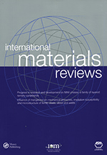
INTERNATIONAL MATERIALS REVIEWS
Transforming Research into Practical ApplicationsINTERNATIONAL MATERIALS REVIEWS, published by SAGE Publications Inc, is a leading journal dedicated to the comprehensive analysis of contemporary research in the fields of materials chemistry, mechanical engineering, mechanics of materials, and the study of metals and alloys. With an impressive impact factor and a Q1 ranking across multiple categories such as Materials Chemistry and Mechanical Engineering in 2023, it ranks amongst the top journals for innovative materials research. The journal has a long-standing history since its inception in 1987 and continues to serve as a crucial resource for academics and professionals alike. Although it is not open access, it is renowned for its rigorous peer-review process and its commitment to disseminating high-quality materials science research globally. Researchers, students, and industry professionals benefit greatly from the journal's insightful reviews, both for the advancement of theoretical knowledge and practical applications within the fast-evolving materials field.
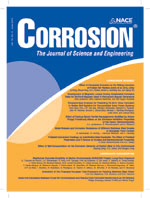
CORROSION
Unveiling Insights for Sustainable Engineering PracticesCORROSION is a prestigious journal published by the Natal Association of Corrosion Engineers, dedicated to advancing the understanding of corrosion phenomena in various materials across multiple industries. With a strong commitment to high-quality research, it has established itself as a key resource in the fields of Chemical Engineering, Chemistry, and Materials Science, as reflected in its Q3 ranking in the 2023 category quartiles. This journal, retaining its relevance since 1969, serves as a platform for innovative studies and findings that address fundamental and applied aspects of corrosion, vital for professionals engaged in material selection and integrity management. Through access to state-of-the-art research, CORROSION significantly contributes to the safety, sustainability, and efficiency of engineering practices worldwide. Researchers, professionals, and students alike can benefit from the insights offered by this journal, driving forward the quest for innovative solutions in corrosion management.

Structural Integrity and Life-Integritet I Vek Konstrukcija
Advancing Structural Excellence and Safety.Structural Integrity and Life - Integritet I Vek Konstrukcija is a prominent open-access journal dedicated to advancing the fields of Civil and Structural Engineering, Mechanics of Materials, and Safety, Risk, Reliability, and Quality. Published by the SOC STRUCTURAL INTEGRITY & LIFE, this journal has been disseminating high-quality research since 2001 from its base in Belgrade, Serbia. The journal's commitment to open access ensures that vital research is freely accessible to a global audience, fostering collaboration and innovation within the academic community. With an impressive categorization in the 2023 quartiles, including Q2 in Metals and Alloys and Q3 in related fields, Structural Integrity and Life stands as a vital resource for researchers, professionals, and students striving to enhance understanding and applications in structural integrity and material performance. The journal invites contributions that address critical issues in the field, pushing the boundaries of knowledge and practical applications, and welcomes both empirical studies and theoretical discussions that can drive forward the next generation of engineering solutions.

KOVOVE MATERIALY-METALLIC MATERIALS
Advancing the Science of Metallic MaterialsKOVOVE MATERIALY-METALLIC MATERIALS, published by REDAKCIA KOVOVE MATERIALY, is a prominent journal embedded within the field of materials science, focusing particularly on metallic materials. With a history dating back to 1968, this Slovakian journal has made significant contributions to the understanding of materials chemistry, mechanical engineering, and the mechanics of materials. While currently classified in the Q4 category for Materials Chemistry and Mechanical Engineering, and Q3 for Metals and Alloys, it aims to provide a platform for high-quality research and novel findings in these domains. Furthermore, the journal is indexed within Scopus, reflecting its engagement with the global scientific community and its role in disseminating pivotal studies. Researchers, professionals, and students will find crucial insights and developments in the field, making it a valuable resource for those seeking to enhance their understanding of metallic materials and their applications.

Acta Metallurgica Slovaca
Connecting academia and industry through cutting-edge findings.Acta Metallurgica Slovaca is a distinguished open-access journal published by SCICELL SRO that has been pivotal in the field of Materials Science and Metallurgy since its inception. With a robust commitment to disseminating high-quality research, this journal covers a wide array of topics within the scope of metals and alloys. Now indexed in Scopus, it ranks 82nd out of 176 in its category, reflecting a growing influence within the scientific community. With a quartile ranking of Q3 as of 2023, Acta Metallurgica Slovaca serves as an essential platform for researchers and professionals seeking to share innovative findings and developments in metallurgical science. Open access since 2013, it ensures that research is accessible to all, fostering collaboration and engagement across academia and industry worldwide. With a converged publication timeline extending from 2009 to 2024, this journal continues to play a crucial role in advancing knowledge and addressing contemporary challenges in the metallurgy sector.